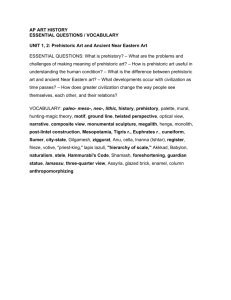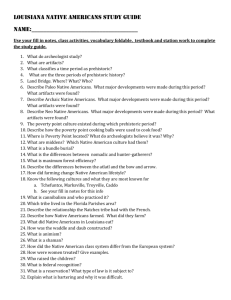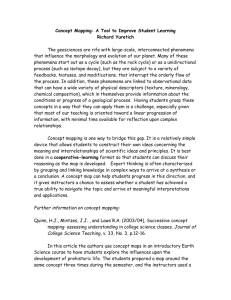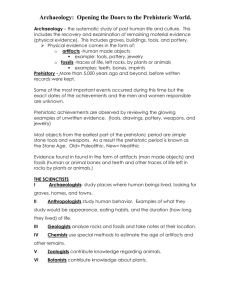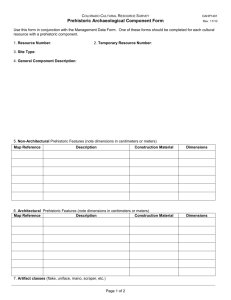Prehistoric Indians of Arkansas: Body Decoration & Adornment
advertisement
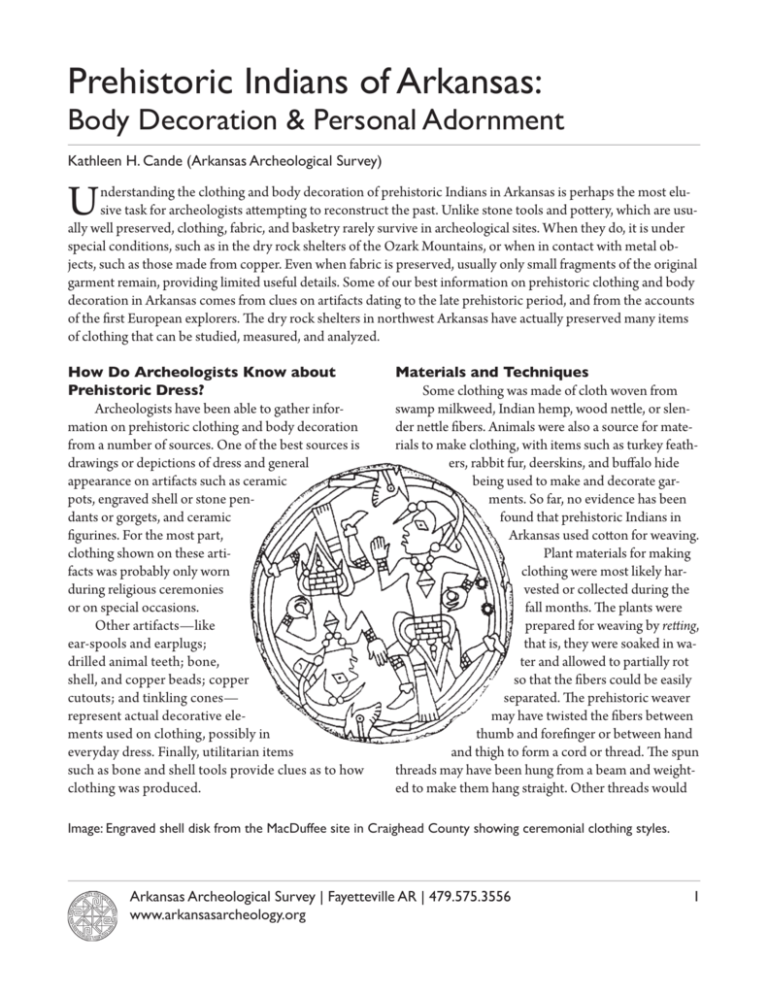
Prehistoric Indians of Arkansas: Body Decoration & Personal Adornment Kathleen H. Cande (Arkansas Archeological Survey) U nderstanding the clothing and body decoration of prehistoric Indians in Arkansas is perhaps the most elusive task for archeologists attempting to reconstruct the past. Unlike stone tools and pottery, which are usually well preserved, clothing, fabric, and basketry rarely survive in archeological sites. When they do, it is under special conditions, such as in the dry rock shelters of the Ozark Mountains, or when in contact with metal objects, such as those made from copper. Even when fabric is preserved, usually only small fragments of the original garment remain, providing limited useful details. Some of our best information on prehistoric clothing and body decoration in Arkansas comes from clues on artifacts dating to the late prehistoric period, and from the accounts of the first European explorers. The dry rock shelters in northwest Arkansas have actually preserved many items of clothing that can be studied, measured, and analyzed. How Do Archeologists Know about Prehistoric Dress? Archeologists have been able to gather information on prehistoric clothing and body decoration from a number of sources. One of the best sources is drawings or depictions of dress and general appearance on artifacts such as ceramic pots, engraved shell or stone pendants or gorgets, and ceramic figurines. For the most part, clothing shown on these artifacts was probably only worn during religious ceremonies or on special occasions. Other artifacts—like ear-spools and earplugs; drilled animal teeth; bone, shell, and copper beads; copper cutouts; and tinkling cones— represent actual decorative elements used on clothing, possibly in everyday dress. Finally, utilitarian items such as bone and shell tools provide clues as to how clothing was p­ roduced. Materials and Techniques Some clothing was made of cloth woven from swamp milkweed, Indian hemp, wood nettle, or slender nettle fibers. Animals were also a source for materials to make clothing, with items such as turkey feathers, rabbit fur, deerskins, and buffalo hide being used to make and decorate garments. So far, no evidence has been found that prehistoric Indians in Arkansas used cotton for weaving. Plant materials for making clothing were most likely harvested or collected during the fall months. The plants were prepared for weaving by retting, that is, they were soaked in water and allowed to partially rot so that the fibers could be easily separated. The prehistoric weaver may have twisted the fibers between thumb and forefinger or between hand and thigh to form a cord or thread. The spun threads may have been hung from a beam and weighted to make them hang straight. Other threads would Image: Engraved shell disk from the MacDuffee site in Craighead County showing ceremonial clothing styles. Arkansas Archeological Survey | Fayetteville AR | 479.575.3556 www.arkansasarcheology.org 1 then have been woven or twisted by hand across the weighted threads in an over and under pattern. It is possible that bone or shell tools were used to weave the fibers through the weighted threads. This type of weighted loom is one of the simplest and probably the earliest looms used in North America. It was probably used throughout the entire United States during prehistoric times. Unfortunately no prehistoric loom has yet been found east of the Rocky Mountains. Fabric may have been woven in the winter or some thread reserved for future use. In the spring, raw materials stored over the winter months may have been processed and clothes woven if enough prepared material was on hand. During late summer, decisions about which plants needed to be gathered and in what quantities might have been made. Dyes could have been made at any time during the year depending on the availability of plants used to make them. Plants such as butternut, cedar, sumac, chokecherry, rose hips, ground lichen, and goldenrod produced dyes for fabric. Pigments like red ocher, black lead, and tobacco pipe clay were used to make face paint. Clothes Worn The largest and most complete items of prehistoric clothing in the southeastern United States were found at the Spiro Mound site in eastern Oklahoma during the late 1930s. The Spiro site was a large village and ceremonial center occupied by prehistoric Caddo Indians from about a.d. 800 to a.d. 1450. The textiles and clothing were found in a large mound that had a central burial area or “hollow chamber.” It is believed that the textiles were preserved through a combination of dry conditions within the chamber and contact with copper artifacts. The most spectacular items of clothing at Spiro are feather- and fur-wrapped mantles or cloaks. The feathers and dyed fur were woven into a framework of fiber to create these garments. These cloaks probably were worn during religious ceremonies or special occasions. Also found at the Spiro site were headbands or caps, thought to represent portions of elaborate headdresses, and skirts. Many of these objects were A bundle of plant-fiber thread from the Arkansas Ozarks. dyed in shades of red, yellow, and black. Fiber artifacts preserved in the dry Ozark rock shelters include feather capes and bags of feather down cloth. These archeological remains provide a framework for understanding clothing styles that can be expanded by examining other prehistoric artifacts and written accounts by early European travelers. The chronicles of early European explorers in the Southeast provide a wealth of descriptive information about clothing, body painting, tattooing, staining of the teeth, hair styles, and decorations. Other details are found on artifacts such as decorated ceramic pots, human figurines, and carved stone pipes like the famous Resting Warrior pipe from Spiro. The typical dress for men consisted of a breechcloth made of leather or sometimes woven grass, tied with a sash. Leather moccasins or shoes woven from grasses were worn, and in colder weather, fur and feather mantles, sometimes decorated with painted designs. Women wore skirts of deerskin, moss or mulberry cloth, leather moccasins or grass sandals, and feather or hide mantles. In addition to basic dress items, prehistoric inhabitants of the Southeast wore hair ornaments of shell and metal beads, fur, headbands with feathers, Arkansas Archeological Survey | Fayetteville AR | 479.575.3556 www.arkansasarcheology.org 2 beads, and sweet grass, nose ornaments, necklaces, rings, bracelets and arm bands, and leg ornaments consisting of fur wrapped cordage or strings of beads. Other Body Decorations Late prehistoric “head pots” and shell engraving indicate the importance of tattooing and body painting for the Southeastern Indians. Men painted their bodies on all important occasions. Elaborate designs were painted on their faces, shoulders, and chests using red, black, and yellow pigments. Women used body paint infrequently. Tattooing was accomplished by piercing the skin with sharp bone needles dipped in red cinnabar (vermilion) and lamp black (soot). Designs were both geometric and representational and probably covered the face, chest, arms, and legs. Staining the teeth of women in some tribes was also an established custom. This was accomplished with a mixture of tobacco and wood ash. A much more drastic means of alteration of physical appearance was practiced by the Caddo, Natchez, and Tunica tribes. This was deformation of the forehead during infancy to create a flat sloping forehead that was considered to be beautiful. It was done by wrapping the infant in a cradleboard with a wooden panel to shape the pliable bones of the skull. A headpot showing painted or tattooed face and piercings for ear ornaments. For Further Reading Densmore, Frances 1974 How Indians Use Wild Plants for Food, Medicine, and Crafts. Dover Publication, New York. Fundaburk, Emma L. and Mary D. F. Foreman (editors) 1957 Sun Circles and Human Hands:The Southeastern Indians Art and Industries. Paragon Press, Montgomery, Alabama. Hudson, Charles 1976 The Southeastern Indians. University of Tennessee Press. Scholtz, Sandra Clements 1975 Prehistoric Plies: A Structural and Comparative Analysis of Cordage, Netting, Basketry, and Fabric from Ozark Bluff Shelters. Reprinted 2006. Research Series No. 9. Arkansas Archeological Survey, Fayetteville. Arkansas Archeological Survey | Fayetteville AR | 479.575.3556 www.arkansasarcheology.org 3
